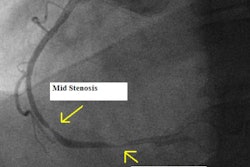Screening for the largest virtual colonoscopy trial to date won't be finished for months, but researchers are already pondering how the National CT Colonography Trial results might alter the colon cancer screening landscape in the U.S.
In a recent talk, one radiologist predicted things will turn out pretty well -- with sensitivity falling somewhere between the best and worst of the large published trials -- and that VC will gain new traction in the post-ACRIN world as a result.
For now such predictions are mere speculation, of course, but a little planning never hurt. Meanwhile, ACRIN 6664 is progressing more or less on schedule. Total recruitment stood at 1,349 patients on the first of February. A preliminary analysis of the interim results for all sites is scheduled for this month, said Carrie Phillips, study coordinator for the Mayo Clinic in Rochester, MN, in a telephone conversation with AuntMinnie.com.
The results of the interim analysis will remain confidential, but one thing the investigators will be looking at is the number of clinically significant lesions detected at each site, in an effort to ensure the study's statistical power. Each center is aiming for about 150 patients, but with the more important goal of detecting about a dozen clinically significant lesions per center.
"We have now crossed the halfway mark for patient recruitment; however, the total number of patients to recruit is predicated upon the number of lesions that are present in the population," wrote lead investigator Dr. C. Daniel Johnson, also from the Mayo Clinic, in a February 6 e-mail to AuntMinnie.com.
On the payor side, local carriers continue to see an incremental expansion of diagnostic VC indications, but few expect the U.S. Congress to revisit widespread screening reimbursement until it sees the results of the $7 million trial it's funding.
The primary aim of the 15-center ACRIN Protocol 6664 is to evaluate the sensitivity of VC in subjects with at least one clinically significant polyp (10 mm or larger) compared to optical colonoscopy as a reference standard. For the detection of such lesions, the three largest VC trials to date have yielded sensitivity results ranging from a high of 94% to a low of 55% for the detection of lesions approximately 1 cm and larger (New England Journal of Medicine, December 4, 2003, Vol. 349:23, pp. 2191-2200; Journal of the American Medical Association, April 1, 2004, Vol. 291:14, pp. 1713-1719; Lancet, January 22-28, 2005, Vol. 365:9456, pp. 305-311).
The ACRIN trial, it is hoped, will offer an honest assessment of VC's current capabilities among trained readers equipped with 16-detector scanners or better, cathartic prep, and both fluid and stool tagging.
If ACRIN achieves at least moderately good results, demand for it is expected to increase, which will require a corresponding increase in the capacity to perform VC.
Screening is tentatively scheduled for completion by June 2006, Johnson said at the at the 2005 International Symposium on Virtual Colonoscopy in Boston. "The results vary in this environment of changing technology, and so this isn't a marathon -- this is a sprint in order to get this done with at least 16-row scanners to understand where we are today," he said.
The centers are recruiting a screening population of asymptomatic outpatients 50 and older who are already scheduled for colonoscopy, Johnson said. The protocol includes administration of tagging agents for stool (12 g total barium) and fluid (30 mL both evening and morning, MD-Gastrovue, Mallinckrodt, Hazelwood, MO) for three meals before the cathartic prep with polyethylene glycol or magnesium citrate.
"We want to make sure patients are well-hydrated," Johnson said. "We have found that in patients who are poorly hydrated, sometimes the barium will stick to the lining of the colon." Glucagon (1 mg) will be administered subcutaneously in a bid to maximize patient comfort. Automated CO2 insufflation will be performed on an insufflator (PROTOCO2L, E-Z-EM, Lake Success, NY). Sites have the option of converting to manual insufflation if they find automated insufflation inadequate, Johnson said.
The researchers will acquire supine and prone images, with the option of obtaining decubitus views if needed, Johnson said. All scanners have a minimum of 16 detector rows, though some facilities have installed 64-slice machines. The largest allowable collimation is 2.5 mm, reconstructed in 1-mm-thick slices at 50 effective mAs for a normal-sized patient.
Reader training has been emphasized, with specialized required training for every reader with fewer than 500 proven reads. Even if they had all those reads, they still had to go through a certifying examination, which included 20 proven cases and required a passing score of 90% or better for easy or moderately difficult polyps, Johnson said.
"I think most people would say colonoscopy's going to find 90% of easy or moderately difficult polyps, so we wanted to make sure we were in the ballpark," Johnson explained.
Every center is required to use a workstation that had both 2D and 3D fly-through capabilities, and the data are to be read randomly twice by two independent readers -- first 3D with 2D problem solving, then the opposite. The pathology of all excised lesions will be examined.
Plenty of secondary research is planned as well. Dr. Ronald Summers from the National Institutes of Health in Bethesda, MD, will compile a database for computer-aided-detection research. Statistician David Vanness, Ph.D., from the University of Wisconsin in Madison will examine cost-effectiveness. Dr. Abraham Dachman from the University of Chicago will study extracolonic abnormalities. Dr. Amy Hara from the Mayo Clinic in Scottsdale, AZ, will delve into software preferences, and Dr. Martina Morrin from Beth Israel Deaconess Medical Center in Boston will study patient preferences, Johnson said.
Following Johnson's talk, Dr. Jay Heiken from the Mallinkrodt Institute of Technology in St. Louis took the stage to discuss potential ramifications of ACRIN, warning that his predictions were based on incomplete data.
"Prediction is very difficult -- especially about the future," Heiken said in a nod to Danish physicist Neils Bohr. As for his own prediction, Heiken said that ACRIN II would likely garner sensitivity results of 75% to 85% for significant colorectal lesions.
"In a broad-based study involving 15 institutions, I don't think we can expect to do quite as well as Perry (Pickhardt) and his colleagues did (94%), and on the other hand I don't think we'll do nearly as poorly as the other studies would seem to show for VC (55% to 75%)," he said.
If results can indeed be achieved somewhere in the middle, VC will be established in the public's mind as a legitimate screening tool, he said.
"There will be substantially increased demand once the public is aware that there is a good noninvasive test available," Heiken said. "And I think the main effect on third-party payors will essentially be panic. The reason I say that is because third-party payors look at the costs of screening the way hospital administrators look at buying new radiology equipment. They don't look at the costs that are going to be saved down the line or the income that will accrue down the line; they look at the money they're going to have to spend today."
Heiken's rudimentary cost model, served with emphatic disclaimers, pegged screening costs for optical colonoscopy at $67 per year for examination once per decade, compared to $111 for virtual colonoscopy screening every five years. Annual fecal occult blood testing combined with flexible sigmoidoscopy came up at $46 per year.
Costs will rise if screening compliance grows as a result of VC's popularity, and they will also increase in proportion to the number of people who switch from colonoscopy to virtual colonoscopy for surveillance, and from the sheer weight of demographic pressures. Of approximately 75 million people 50 and older in the U.S., only 25% to 40% of whom are compliant with current screening guidelines, he said.
If VC increases screening compliance among those not being screened, and some of those being screened by other means switch to VC, the costs could increase by billions of dollars.
In response to audience questions, Heiken acknowledged a more complex model would incorporate total programmatic costs of screening such as those associated with colonoscopy referrals from VC, and the savings realized by preventing colorectal cancer and its associated costs, currently estimated at $80,000 per year per patient.
"My predictions are ... that this study will establish VC as a legitimate colon cancer screening test, and as a result there will be a substantially increased demand by the public for this procedure," Heiken said. "Two questions that remain to be answered are, one, will the major health organizations such as the American Cancer Society and others endorse VC for screening? And two, will third-party payors cover VC for this procedure? My prediction is that the answers to both of these questions are yes, what's not as clear is the timeline for this to take place, and the specifics of how this will be done."
By Eric Barnes
AuntMinnie.com staff writer
February 10, 2006
Related Reading
Adverse events weigh on colonoscopy mortality equation, February 6, 2006
Two new VC trials under way in Europe, November 22, 2006
VC would raise screening costs, study concludes, October 31, 2005
Multicenter VC trial begins with high hopes, state-of-the-art, March 1, 2005
Duke VC trial results disappointing, November 1, 2004
Copyright © 2005 AuntMinnie.com



















